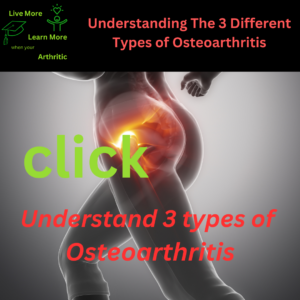
Secondary Osteoarthritis: 2 of 3 types of Osteoarthritis
Impact of Secondary Osteoarthritis on Joints
Secondary osteoarthritis can affect various joints in the body, with certain joints being more commonly impacted than others. Here is an order of the most affected joints, from most to least common:
Here are the links to each remaining Osteoarthritis article covered in this 4 part series:
- Knees: The knee joints are frequently affected by secondary osteoarthritis, especially in individuals with a history of knee injuries or surgeries.
- Hips: Secondary osteoarthritis often affects the hip joints, particularly in people who have experienced hip fractures or other trauma.
- Hands and Fingers: In some cases, osteoarthritis can develop in the hands and fingers, particularly after injuries or repetitive strain.
- Spine: Secondary osteoarthritis may affect the spine, especially in individuals with prior spinal injuries or degenerative conditions.
Disease Description
Secondary osteoarthritis is a form of osteoarthritis that develops as a result of underlying factors such as joint injuries, trauma, congenital joint abnormalities, or other joint diseases. Unlike primary osteoarthritis, which occurs due to aging and wear and tear, secondary osteoarthritis has specific causative factors.
Causes and Triggers
The causes of secondary osteoarthritis can vary, but common triggers include:
- Joint injuries from accidents, sports, or falls
- Previous joint surgeries that alter joint mechanics
- Congenital joint abnormalities or malformations
- Underlying joint diseases like rheumatoid arthritis or gout
Symptoms and Limited Range of Motion
Symptoms of secondary osteoarthritis include:
- Joint pain, especially with movement or weight-bearing
- Swelling and stiffness in affected joints
- Limited range of motion, making it difficult to perform daily activities
The limited range of motion is often due to joint damage, inflammation, and the development of osteophytes (bone spurs) that restrict joint movement.
Age of Onset and Impact on Lifespan
Secondary osteoarthritis can occur at any age but is more common in older adults who have experienced joint injuries or surgeries earlier in life. The condition can impact lifespan by reducing mobility and increasing the risk of complications like joint deformities or osteoarthritis-related comorbidities.
Autoimmune Nature and Risk Factors
Secondary osteoarthritis is not considered an autoimmune disease. Risk factors include:
- History of joint injuries or trauma
- Genetics, including congenital joint abnormalities
- Occupation or sports activities that place repetitive stress on joints
- Underlying joint diseases that affect joint health
Complications and Inflammation
Inflammation plays a lesser role in secondary osteoarthritis compared to inflammatory arthritis conditions. However, joint swelling and inflammation can occur following acute injuries or surgeries, contributing to osteoarthritis development.
Joint Tenderness and Cartilage Loss
Tenderness in affected joints is common due to inflammation and cartilage degeneration. Over time, cartilage loss leads to joint pain, stiffness, and functional impairment.
Impact on Range of Motion
Loss of range of motion in secondary osteoarthritis is primarily attributed to joint damage and structural changes. Osteophytes, joint instability, and soft tissue changes can restrict joint movement over time.
Achieving a Higher Quality of Life
A proactive approach can improve quality of life with secondary osteoarthritis:
- Regular low-impact exercise to strengthen muscles and maintain joint flexibility
- Weight management to reduce stress on affected joints
- Physical therapy to optimize joint function and mobility
- Use of assistive devices and ergonomic modifications for daily activities
Possible Complications and Age Distribution
Complications of secondary osteoarthritis include:
- Joint deformities that impair mobility
- Chronic pain and disability affecting daily life
- Increased risk of osteoarthritis-related comorbidities like cardiovascular disease
Secondary osteoarthritis commonly affects individuals who have experienced joint injuries or surgeries earlier in life. While both men and women can develop secondary osteoarthritis, the prevalence may vary depending on the underlying causes and risk factors.
 Interconnected Diseases and Conditions
Interconnected Diseases and Conditions
People with secondary osteoarthritis may be at risk for related conditions, including:
- Post-traumatic osteoarthritis in joints affected by previous injuries
- Degenerative joint diseases like osteoporosis or avascular necrosis in affected joints
These interconnected conditions highlight the importance of early intervention and comprehensive management to optimize outcomes and improve quality of life for individuals with secondary osteoarthritis.
Enjoy read 4 more articles about Osteoarthritis:


